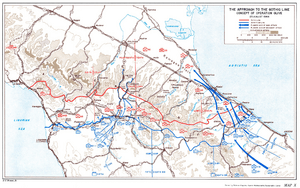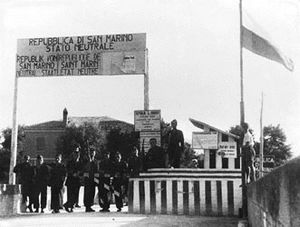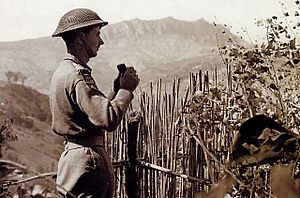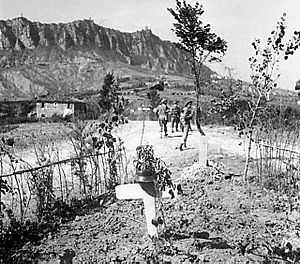Battle of San Marino facts for kids
Quick facts for kids Battle of San Marino |
|||||||
|---|---|---|---|---|---|---|---|
| Part of the Gothic Line Offensive during the Italian Campaign (World War II) | |||||||
 The initial plan for Operation Olive, the attempt to break the Gothic Line (red); the planned offensive is shown in blue, along the eastern coast. The arrows converge north of San Marino. |
|||||||
|
|||||||
| Belligerents | |||||||
|
|
|||||||
| Commanders and leaders | |||||||
| Casualties and losses | |||||||
| 274 killed 54 captured |
323 killed | ||||||
The Battle of San Marino was a fight that happened from September 17 to 20, 1944. It was part of the Italian Campaign during World War II. During this battle, German soldiers took over the neutral country of San Marino. Then, soldiers from the Allied forces attacked them. This battle is sometimes called the Battle of Monte Pulito.
San Marino had said it would stay neutral (not pick sides) earlier in the war. For a while, the war didn't really affect it. But in 1943, Allied forces moved far up the Italian Peninsula. A big German defense line, called the Gothic Line, was built close to San Marino's border. In June 1943, the Royal Air Force bombed San Marino. They thought German soldiers were hiding there. About 35 people died in this bombing.
In August 1944, the Allies started a big attack called Operation Olive. They aimed to break through the Gothic Line near Rimini, a city east of San Marino. The plan was to go around San Marino completely. But because of the Allied movements, the Germans sent a small group of soldiers into San Marino. They wanted to protect their supply routes and watch for enemy movements from the mountains.
After a few days, the main Allied attack near Rimini slowed down. This was because of strong German resistance and bad weather. British and Indian soldiers then started moving west, bringing the battle closer to San Marino. On September 17, the 4th Indian Infantry Division attacked German soldiers. These Germans were on two hills just inside San Marino's border. After tough fighting, the situation became more stable on September 19. Allied forces then began to push into the city of San Marino itself. The city was captured by the afternoon of September 20. The 4th Indian Division left San Marino on September 21. Local defense forces then took control of the country.
Contents
San Marino's Neutrality
The tiny country of San Marino is in northern Italian Peninsula. It is completely surrounded by Italy. San Marino had a government that was similar to Benito Mussolini's government in Italy. But San Marino tried to stay neutral during World War II.
In 1940, some reports said San Marino had declared war on the United Kingdom. However, San Marino's government later said this was not true. In 1942, they also said they were not at war with the United States. The US government agreed with this. The British government noted in 1943 that they had never declared war on San Marino. But they also never officially said San Marino was neutral. They felt they could take military action there if German forces used San Marino's land.
On June 27, 1943, Allied planes bombed San Marino. At least 35 people were killed. San Marino's government quickly said that no military bases or equipment were on its land. They also said no soldiers from either side had been allowed in. In early July, they announced that German commanders had put up signs at the border. These signs told German units not to enter San Marino. San Marino again stated it was completely neutral.
The Gothic Line Attack
By late summer 1944, German forces in Italy had moved back to the Gothic Line. This was a long chain of strong defenses across the Italian peninsula. The Allies planned to break through these defenses. They wanted to push north towards Rimini and the flat lands of Northern Italy.
The British Eighth Army led a big attack called Operation Olive. Eleven divisions would attack in a small area. They would meet at the "Rimini Gap," which was an 8-mile wide flat area near the coast. After getting through this gap, they would spread out onto the Romagna Plain. Then they would move west towards Bologna. At the same time, the American Fifth Army would push north in the middle of Italy. The goal was for both armies to meet near Bologna. This would trap a large German force.
The main Allied attack started on August 25. They reached the Foglia valley, where the Gothic Line truly began, on August 29. The line was quickly broken. The German commanders tried to set up a second defense line. This was on the Coriano ridge, a hilly area north of the Conca river. This ridge was the last big natural barrier south of Rimini.
The Allied attack reached the river on September 3. But it stopped because of problems with their tanks, stronger German resistance, and heavy rain. The Allied forces paused and brought in more soldiers. They waited for a chance to restart their attack along the coast. On the left side of the attack, the advance had stopped in the Battle of Gemmano. This was south of the Conca river.
At this point, the Allied forces on the left side were in a line facing west towards San Marino. San Marino was only a few miles away. The 56th (London) Infantry Division was facing Croce. The 46th Infantry Division was facing the heavily defended area at Gemmano. The 4th Indian Infantry Division was south of the 46th. It was the very left edge of the attack.
When the attack on Coriano started again on September 12, these forces pushed west. Their goal was to reach the town of Montescudo, about two miles from San Marino's border. The main attack successfully pushed onto the ridge. The 56th Division moved about 1 mile past Croce. They then dug in for the night of September 13. That night, the 4th Indian Division gained a foothold south of Gemmano. Gemmano was finally captured by the 46th and 4th Indian Divisions on the morning of September 15. The British forces then got ready to move towards Montescudo.
The Battle Begins
Entering San Marino
The 46th Division took Montescudo on September 15. The next day, the 56th Division entered Mulazzano. This town was directly north of Montescudo and also close to the border. The fighting then moved westward from here. The 56th Division was on the northern side, and the 46th was on the south. Both divisions faced strong German resistance.
On September 13, the German Army sent a strong force into San Marino. They wanted to defend it against the Allies. This would also give them control of a main road in the area. It would also let them use the mountain peaks for artillery observers. The German soldiers were from the 278th Infantry Division. The 4th Indian Division was given the job of attacking them on September 17.
The first soldiers of the 4th Indian Division, from the 3rd/10th Baluch Regiment, crossed the Marano River on the eastern border on the night of September 17. The 1st/9th Gurkha Rifles then moved through them. They attacked two small hills called Points 343 and 366 near Faetano. These hills were just behind the river. Two battalions of the 993rd Grenadier Regiment held them. Point 343 was taken at 5:00 AM. But the soldiers at Point 366 had to fall back because they ran out of ammunition. A soldier named Sher Bahadur Thapa was given the Victoria Cross after he died. He held the top of the hill by himself for two hours. This allowed two companies of soldiers to retreat safely. He was killed trying to save another wounded Gurkha soldier.
Point 343 was held through September 18, but 63 men were lost. By the evening, tanks arrived and helped stabilize the position with artillery support. The 4th/11th Sikh Regiment moved around the Gurkhas to the north. They covered the northern side of the San Marino heights. The division's 11th Brigade then moved through them to help surround the city.
On the evening of September 19, the 2nd Battalion, Queen's Own Cameron Highlanders from the 11th Indian Infantry Brigade, began to push into the edges of the city from the north. But early on the morning of September 20, they were stopped by German defenses in the northwest of the city. This was where the road to the upper part of the city, higher on the mountain, began. Tanks moved into the suburbs. A company of the Camerons moved uphill towards the summit in heavy rain. The city was secured by early afternoon. Only 24 attackers were hurt, and 54 German soldiers were captured.
On September 21, local defense forces helped round up any remaining German soldiers. The 4th Indian Division then moved on through a strong storm and left the country.
What Happened Next
Allied forces stayed in San Marino for a short time after the Germans gave up. In October 1945, after the war ended, San Marino's government asked the British government for 732 million lira as war payment. Of this, 500 million lira were for the costs of the fighting in September. Another 20 million lira were for the costs of the Allied occupation.
The British government said no to this request. They argued that Germany had broken San Marino's neutrality before Allied troops entered the country. So, Britain was not responsible. However, Britain did offer a payment of £26,000 for the June bombing. This was later increased to £80,000 (which was equal to 32 million lira).
The special award "San Marino" was given to three British Army units. These were the Royal Lincolnshire Regiment, the York and Lancaster Regiment, and the Queen's Own Cameron Highlanders. Two Indian Army units also received it: the 1st/9th Gurkha Rifles and the 4th/11th Sikh Regiment. The last three units fought as part of the 4th Indian Division in the main attack. The first two units had battalions in the 138th Infantry Brigade of the 46th Division.
Images for kids





